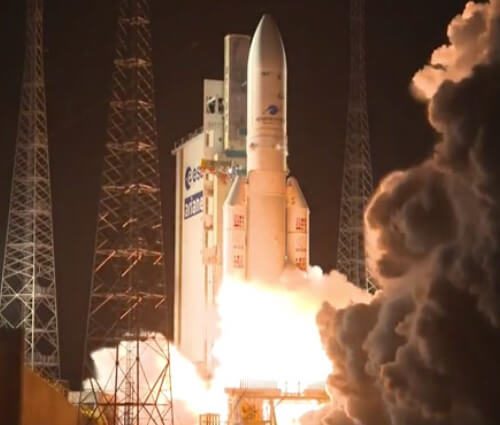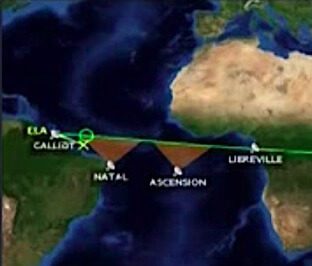The Ariane 5 rocket has had its first actual launch failure after 82 successful flights performed over 15 years. Following an apparently successful lift-off from the Kourou launch site at 1920 GMT on 25 January 2017, the Ariane 5 ECA flight VA241, carrying SES-14 and Al-Yah 3 communications satellites, suffered a launch anomaly when contact was lost seconds into the firing of its upper stage. Despite no signal from the launch vehicle (second tracking station located in Natal, Brazil, could not pick this up), the first and heaviest of the satellite pair, SES-14, was later confirmed as having separated as planned, as was the Al-Yah 3 spacecraft which had been due to be released some eight minutes later.

Ariane 5ECA launch carrying Al Yah 3 and SES-14. Courtesy: Arianespace
However, SES-14’s owner and operator SES later confirmed that the satellite had been put into a different transfer orbit than planned. The launch was originally planned to achieve a “super-synchronous” elliptical transfer orbit (45,234 x 250km orbit at 3 degrees inclination) with an apogee over 9,000km higher than the 36,000km of a “normal” elliptical geosynchronous transfer orbit (GTO). This higher apogee is more efficient for orbital inclination removal and overall fuel efficiency, even though it has to be lowered back to 36,000km (in addition to the perigee being raised) in order to reach the circular 36,000km geostationary Earth orbit (GEO).
Reports from US Strategic Command (Stratcom) indicate that the spacecraft were left in orbits circa 43,200 x 232km which is only slightly lower than planned, but with inclination of nearly 20 degrees – a dramatically different inclination from the one expected. This would seem to indicate a major guidance or software error during the flight.
Given the latitude of the Kourou launch site, an Ariane 5 ECA launch flying due East (to maximise the benefit of the Earth spin boost) would normally fly into a five degree inclined transfer orbit with a ground track appearing to be in a slightly south easterly direction. However, to partly reduce this inclination from five degrees to three degrees, some launches make a “dog leg” left turn during the flight, usually during the ESC-A second stage burn.
However In this case, from lift off, the EPC first stage launch heading appeared to have a ground track being in a much more southerly direction than expected. This trajectory error appears to have compounded the inclination of the finally achieve transfer orbit up to more than 20 degrees compared to the planned inclination of three degrees. While still heading South East, the unexpectedly more southerly track would also account for the loss of signal reception from the station at Natal (see track below).

The faulty ground track (shown yellow) was initially faithfully shown on the CNES display of the launch. It is veering further south of its planned South Easterly track (green). Courtesy: CNES
The fact that Arianespace was “aiming high” for the transfer orbit’s apogee (super-synchronous transfer orbits are rarely used by Arianespace) might have made the inclination inaccuracy less damaging than would otherwise have been the case.
SES later reassured its clients and insurers that its Airbus built SES-14 spacecraft was still expected to reach its final position in GEO using its electric thruster propulsion, albeit some four weeks later than planned. The spacecraft was insured for US$350 million although no claim for loss of any of its design life is expected due to extra fuel reserves carried for its electric propulsion system which was always planned to be used both for final orbit raising and in orbit operations.
Yahsat, the owner of Al-Yah 3, announced that its satellite was on its way to GEO and that it was expected to reach its operational position. However, there was no word about whether or not its design life would be affected.
Al-Yah 3 carries both conventional bi-propellant chemical apogee motor propulsion for orbital circularisation and inclination removal, but has electric thrusters for small orbital manoeuvres. These are likely be pressed into service for the recovery – and that might incur a significant life loss and generate an insurance claim. Because of the relatively small size of the Orbital ATK-built satellite, and the fact that it was planned to fly “all electric” after final orbital positioning, the spacecraft is not thought to have significant reserves of conventional propellants for the apogee motor. If there is a partial lifespan loss, then this could result in a claim for a partial insurance loss being made.
The Al-Yah 3 was insured under two main policies. One covered the satellite to a value of US$195.8 million for launch plus one year in orbit, the other provided an extra US$30 million of cover for total loss only.
A full independent commission has been set up to mount an investigation into the cause of the partial failure. All future Ariane 5 flights are expected to be suspended until the results of this are evaluated.







